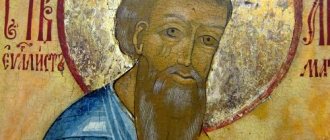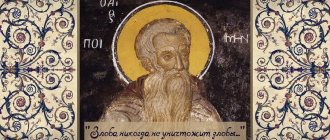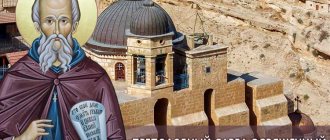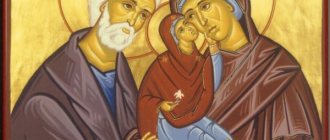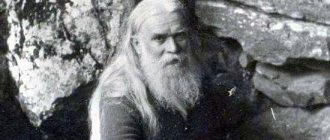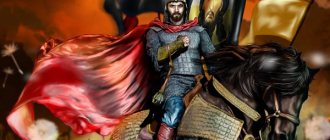From Athos - to the Kyiv land
The history of the Kiev-Pechersk Monastery originates from the Monk Anthony of the Pechersk . He was born in 983, five years before the baptism of Rus', and was named Antipas. From an early age his genuine faith was evident. When Christianity was just being established in Rus', the first churches were being born, Antipas made a pilgrimage to Palestine to see the places of the Savior’s earthly life. On the way back, he visited Athos, where he soon took monastic vows, and under the new name Anthony labored on the Holy Mountain.
But after a few years, the abbot of the monastery learned God’s will about the monk Anthony - to establish the Christian faith in Rus' by his example. So the future saint returned to his native land. In the center of Rus' - Kyiv - he visited all the newly formed monasteries, but did not find a place for himself. Therefore, he settled then still far from the city, on the Kyiv mountains, in a lonely cave. Previously, priest Hilarion, the future Metropolitan of Kiev, lived in it.
The history of the Kiev-Pechersk Monastery actually began with this cave. It is believed that the monastery was founded by Anthony and Theodosius of Pechersk. But in fact, Saint Anthony was the founder; Theodosius came after and became the abbot of the monastery. But more on that a little later.
Conflict with Prince Izyaslav
But it was not only the joy of spiritual communication that the laypeople who came to them brought to the monks. They were the result of their comings and sorrows, integral to our earthly life. The short life of Anthony of Pechersk gives such a sad example. One day two Kievites came to him - the son of a noble boyar named Varlaam and the prince's eunuch Ephraim. Both of them wished to become monks and were soon tonsured. However, such a godly deed had the most unexpected and regrettable consequences for the entire brethren.
When Varlaam’s father learned about his son’s tonsure, he, without feeling the slightest sympathy for his action, came to the caves with his numerous servants. Having pushed the brethren away in the most inappropriate manner, he forcibly took home the boy who dared to take such an important step in life without his father’s blessing. Anthony and Theodosius of Pechersk experienced what happened with bitterness. But what was their grief when Grand Duke Izyaslav himself was filled with anger upon learning of the tonsure of his beloved eunuch!
Inspired by Anthony's example
Monk Anthony was truly a great ascetic. He ate only black bread, which he consumed every other day, and a moderate amount of water. His days and nights were spent in prayer and work.
This way of life of a monk attracted those who wanted to devote themselves to God. Some simply considered him a holy man, while others wanted to imitate him and also serve the Lord.
Nikon came first, and Theodosius of Pechersky . When 12 monks gathered around Anthony, he gave his blessing to dig a large cave. It had space for a temple, a refectory and cells. What these structures looked like can be seen today in the Far Caves of the Kiev Pechersk Lavra.
Since Anthony always sought solitude, he appointed Varlaam as abbot of the monastery, and he himself moved higher and dug a new cave. But Anthony of Pechersk’s retreat was short-lived: he was again surrounded by monks who wanted to devote themselves to God. This is how the Near and Far caves arose, in which today the relics of the Pechersk fathers rest.
The result of a holy life
In the last years of his life, the holy ascetic, due to lack of strength, withdrew from the management of the monastery he created. He now devoted all his time to prayer and preparation for that great moment when he would be destined to appear before the throne of the Most High. He ended his earthly journey on May 7, 1073. His relics have not been found to this day and, according to church expression, “remain under cover.”
The Kiev Pechersk Lavra, which became the main work of his life, became a model for other monasteries built in Orthodox Rus'. It gave the world many outstanding church figures, among whom were archbishops, preachers and writers who went down in history. For them and for all in whose hearts the truth of Christ lived, the textbook of serving God has always been the repeatedly published life of Anthony of Pechersk. Its brief content can only to a small extent give an idea of the whole variety of spiritual feats he accomplished.
How Anthony ended up in Chernigov
The history of another cave is connected with the life of the monk, this time not in Kiev, but in Chernigov, on Boldina Mountain . Why did the saint leave his monastery and move to a completely different city?
Monks repeatedly face slander against them. This happened with the founder of the Pechersk monastery. Someone told the ruling Kyiv prince Izyaslav that Anthony secretly supported the Polotsk prince Vseslav, who seized power in Kyiv, and even gave him advice. In addition, Izyaslav was offended by the monk because he tonsured his former soldiers into monks.
Prince Svyatoslav of Chernigov decided to secretly bring Anthony of Pechersk to his city. This is how a monastery arose on Boldina Mountain, like the Kiev monastery, dedicated to the Most Holy Theotokos.
The monk lived until he was 90 years old, in his last years finally retiring from administrative affairs and devoting himself entirely to prayer.
Construction of the first building of the future Lavra
However, the monk did not hold any grudge in his heart against those who caused him suffering. Seeing in this only the machinations of the evil one, he opened his heart even wider to all the children of God. And the Lord did not leave him. Soon everyone who had left them gathered in the caves, seeking salvation from the prince’s wrath. The pious monastic life, interrupted by such an unfortunate circumstance, was resumed.
When the number of brethren increased considerably, a wooden church was built on the mountain in the name of the Dormition of the Blessed Virgin Mary - the first building of the future Lavra. During this period, evidence appears of miracles performed by Anthony of Pechersk. The life of the saint is filled with examples of how he healed the sick who came to him and predicted many future events hidden from the eyes of ordinary people. This gift of God puts him on a par with the great saints who once found themselves in the sultry deserts of Egypt. Anyone who carefully reads the life of St. Anthony of Pechersk will no doubt agree with this statement.
Young monk Theodosius
After St. Varlaam, management of the monastery for a long time passed to Theodosius of Pechersk, who, along with Anthony, is considered the founder of the monastery. But what exactly did Theodosius become famous for?
He was about 25 years younger than Anthony and was considered his student. Theodosius came to the monastery somewhere in 1032, at the age of approximately 24 years. Before that, he generally lived in Kursk, served in a church and dreamed of becoming a monk. The words of Christ prompted him to leave his home and his mother:
Whoever loves father or mother more than Me is not worthy of Me. (Matt. 10:37)
When Theodosius found himself in Kyiv, he visited all the monasteries. But no one wanted to make him a monk because of his young age. By God's providence, only Anthony agreed.
Venerable Anthony and Theodosius of Kiev-Pechersk
September 15th is a patronal feast day in our monastery: we honor the memory of the patrons of the monastics, Saints Anthony and Theodosius of Kiev-Pechersk. A lower church was built in our monastery; we call it “cave”, as a prototype of the cave in which the Monk Anthony settled long ago...
“They are, indeed, rightfully considered the fathers of Russian monasticism, although monasteries in Rus' existed before them. But, as they say in the “Tale of Bygone Years”: “There are many monasteries established by the tsars, and the boyars, and the rich, but they are not like those that were established by tears, fasting, prayer and vigil.” Arriving from Mount Athos to Kyiv, the Monk Anthony, having visited all these monasteries, did not find a suitable monastery and was forced to dig a cave for himself.” This is how the famous Kiev-Pechersk Lavra, founded in 1051, began.
St. Anthony of Pechersk, has also been preserved . His baptismal name was Antipas. Born in Lyubech, Chernigov region, in his early youth he left his parents’ home and, by inspiration from above, came to Athos to one of the monasteries. Here Antipas was tonsured with the name Anthony. Pleasing God in everything, he labored in virtues, surprising everyone with his humility and obedience. After some time, the abbot of that monastery received a message from God - to release Anthony to Rus', so that he would plant monasticism in this Christian country, which had recently received Baptism. So, with the blessing of his elders, the saint reached Kyiv. But not finding a monastery there that was the same in spirit as Mount Athos, he dug a cave... The feat of Anthony - a strict ascetic, prayer book, spiritual fighter - was severe.
However, despite the severity of life, the fame of St. Anthony soon spread not only throughout Kyiv, but also throughout other Russian cities. Many came to him for spiritual advice and blessings. Some began to ask to live with him. The first to be accepted was a certain Nikon, a priest, and the second was the Monk Theodosius , who at that time was about 24 years old.
The life of this chosen one of God from the very first years of his youth is remarkable. Born in Vasilevo, near Kyiv, his parents later moved to Kursk. From a young age, he discovered an irresistible attraction to the ascetic life, leading an ascetic life while still in his parents' house. He did not like children's games and hobbies; he constantly went to church. With excellent abilities and rare diligence, he quickly learned to read books, so that everyone was amazed at the boy’s intelligence. At the age of 14, he lost his father and remained under the supervision of his mother - a strict and domineering woman, but who loved her son very much. She punished him many times for his desire for asceticism. And one day, when she found out that Theodosius had secretly left with the pilgrims who were heading to Jerusalem, she caught up with him and beat him hard, pulled him by the hair, knocked him to the ground, and kicked him. Then, tying up her son like a robber, she took him home. Fearing that Theodosius would run away again, she put shackles on him. But nothing could knock out of him the God-given desire for achievement, and the monk stood firmly on this path. So he walked in chains for several days. Then, taking pity on her son, the mother unchained him and begged him not to leave her again. Theodosius promised. But having received freedom, he returned to his asceticism: he still went to church and dressed like a beggar. His mother again tried to persuade Theodosius to give up these exploits and beat him. But worldly life was alien to Theodosius, he could not wear these expensive clothes and eat hearty dishes... Once, coming to church, he heard the words of the Gospel: “Whoever loves his father or mother more than Me is not worthy of Me.” He saw in these words a call from God, prompting him to renounce the world.
One day, when his mother left home, the monk ran away from home again. At God’s discretion, he followed the convoy that was traveling to Kyiv, since Theodosius had heard a lot about the monasteries there, and in three weeks he reached Kyiv from Kursk. But they did not accept him in the Kyiv monasteries, and God’s providence directed him to the Anthony Caves.
“Know, honest father, that God Himself, who foresees everything, led me to your holiness and orders you to save me, and therefore I will fulfill everything that you command me,” said Theodosius, when Anthony began to convince him that life in caves is very difficult and dull. Theodosius took monastic vows and spent whole nights in unceasing prayer, worked hard and joyfully carried out all his obediences. Four years later, his mother found him and with tears asked him to return home, but the saint himself convinced her to stay in Kyiv and accept monasticism at the monastery of St. Nicholas at Askold’s grave.
When quite a few brethren had already gathered in the cave, the Monk Anthony, who invariably strove for solitude, withdrew into a hermitage on a neighboring mountain, dug himself a cave here and began to asceticize in the hermitage (now: Near or Anthony's Caves)
The Monk Theodosius remained in the same place. He was soon elected by the brethren as abbot as “the most obedient, humble and meek.” With his blessing, a monastic charter was introduced, brought from Constantinople. This charter passed from the Pechersk Monastery to all other Russian monasteries, and therefore the Monk Theodosius is called “the head of the general monastic life in Russia” and the Kiev-Pechersk Monastery is “the oldest of all Russian monasteries.”
“Since then, two types of monastic life have been defined in Rus' according to its two models, revealed by the Monks Anthony and Theodosius. The first is solitude in caves and seclusions, a particularly difficult and high feat. The second is a monastic community, which instills in the brethren such virtues as are necessary for a monk, such as patience, humility, obedience, brotherly love, renunciation of one’s own will and submission to the rules of the monastic charter.”
Soon the underground monastery could no longer accommodate the numerous brethren, and then the first above-ground cells appeared and the construction of a church began in the name of the Dormition of the Blessed Virgin Mary, which served as the beginning of the great Pechersk Lavra. Later, when monastic life was transferred from the caves to the surface, the deceased inhabitants of the monastery began to be buried in underground labyrinths. Burials in caves have been carried out for more than seven centuries.
Having become rector, the Monk Theodosius did not change his usual behavior. He continued to humble himself, as if he were the least of all, remembering the words of the Savior: “Whoever wants to be first among you must be your slave.” Instructing the brethren in virtues, he himself set an example. “Reverend Theodosius, with the greatest care and love, followed the spiritual development of all the brethren and did not miss the opportunity to give everyone decent instruction. When he taught, he spoke quietly, humbly, as if begging the one to whom he was addressing; when he denounced the culprit, tears flowed from his eyes. If any of the brethren were tempted by evil spirits, he called on him, convinced him not to weaken in the struggle, pointed to the experiences of ascetics and strengthened the tempted one with the power of his prayer. Many miracles happened through his prayers.”
But the quiet mentor could be persistent and firm when it came to the fight for the desecrated truth. Thus, serving the truth brings the saint into conflict not only with judges, but also with princes, for which he is ready to go into exile and death.
In addition to his ascetic deeds, the Monk Theodosius was distinguished by his great mercy towards the poor and love for spiritual enlightenment, and tried to win over his brethren towards them. In the monastery he built a special house for the living of the poor, the blind, the lame, and the paralytic. In addition, every Saturday he sent a whole cart of bread to prisoners in prison. Hegumen Theodosius not only did not isolate his monastery from the world, but placed it in the closest connection with worldly society. This was his testament to Russian monasticism.
The appearance of Heaven on earth, evidence of the compassionate “God’s” love, the joy of the Cross and Resurrection, an image of true humanity - this is what the ascetics of Kiev, Anthony and Theodosius’ disciples were, whose example still inspires us and will not cease to attract creative, brave, noble people to monastic feats souls until love and nobility dry up on earth.
The death, which the Mother of God informed the Monk Anthony, occurred in the 90th year of his life on May 7, 1073. After the death of the saint, God was pleased to hide his relics from people. Those who dared to dig them up were scorched by the fire that came from the grave. His relics, according to God's will, remain hidden.
A year later, in 1074, the death of the Monk Theodosius followed, who predicted the time of his death in advance. His remains were buried in a cave where he retired during fasting. After only 17 years, the relics of the monk were found incorrupt. And in 1108 Theodosius was canonized. Nowadays the whereabouts of the holy relics of the righteous man are unknown. The Far Caves and the source of the Kiev Pechersk Lavra are named after the saint of God.
The Pechersk Monastery little by little became a model for all other monasteries and gained enormous influence on the religiosity of the Russian people in general. From him, the ascetic mood spread throughout society; piety was understood in the very forms in which it was manifested here. The monastery played a significant role in the development of Russian literature, painting, graphics, architecture, applied art, and book printing. Famous chroniclers, writers, scientists, artists, doctors, and book publishers lived and worked in the Lavra. It was here, around 1113, that the chronicler Nestor compiled the “Tale of Bygone Years” - the main source of our knowledge about Kievan Rus.
It was here, in the Lavra, on the Kyiv hills, that for the first time in the history of Russian holiness not one, not two or several, but a whole cathedral appeared - about one hundred and twenty! - miracle workers and righteous people.
“The Lavra caves, consecrated by the prayers of the saints, where their holy and incorruptible relics rest, have been visited by countless pilgrims over the millennium. In the corridors, cells and temples there are tombs with the relics of saints, the incorruption of which you can see with your own eyes. They were touched by death, and, like all mortals, they crossed the threshold of eternity. However, the bodies of God’s saints have not decayed over hundreds of years; on the contrary, they are fragrant and provide healing and help to those who turn to them with faith and sincere prayer; they are living, visible, and convincing evidence of the omnipotence and mercy of God. The incorruption of the holy relics confirms the truth of the victory of our Lord Jesus Christ over death. Here, near the relics of the saints, the heart of every person is given hope that at the end of this temporary life a better life will come, a future that can be filled with unearthly joy and peace.”
Through the prayers of our venerable and God-bearing fathers of the Kiev-Pechersk, may the Merciful Lord grant each of us to achieve perfection to the best of our ability and with His all-powerful help. Amen.
Merits of the new abbot
In 1057, Theodosius of Pechersk became abbot of the monastery. He was not only the greatest man of prayer, but also an excellent leader. With his blessing, a wooden building of the monastery was built, construction began on the main temple - the Assumption, and a monastery library was founded, which was generally a rarity at that time.
But the abbot’s main merit was the adoption of the first charter of the monastery. The basis for it was the studio dormitory charter . What did this mean:
- the property of the monks was common;
- the brethren spent their time in prayer and work;
- it all started with prayer and blessing;
- all the monks confessed to the abbot, revealing their thoughts to him.
In addition, Anthony and Theodosius of Pechersk paid special attention not only to prayer and the life of the brethren, but also to helping those in need. It is known that Saint Theodosius even arranged a special dwelling for the poor and people with special needs, for which tithes from the income of the monastery went. He also took care of the prisoners, sending them a cartload of bread every Saturday.
But the problems of his brethren and the needs of other people did not distract him from prayer. As a student of Anthony, Theodosius was an ascetic and went into seclusion for the entire Great Lent. He only took a little bread into the cave. It was prayer that nourished him. So that nothing would distract from communication with God, he asked the brethren to sprinkle the entrance to the cave. A small window served as a means for meager communication with the monks. Only on Saturday and Sunday could monks approach him and address the abbot with important questions.
The monk died after a short illness at the age of just over 65 years.
